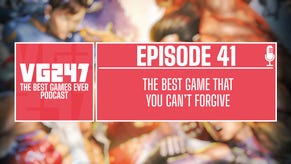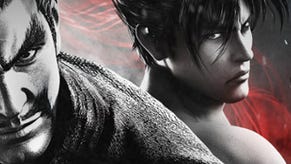Crossing the Line: Hands-on with Street Fighter X Tekken
We don't know our arses from our arcade sticks, so we sent Alex Donaldson our copy of Street Fighter x Tekken to get the low down on just how hardcore this unusual crossover is.
Street Fighter X Tekken has occupied a strange space in my head since its announcement. I’m a massive Street Fighter fan but my knowledge of Tekken is limited, and whilst I’ve enjoyed tag-based Capcom titles stretching back to X-Men vs. Street Fighter in the late 90s I always preferred the one-on-one games by a long shot.
What happens, then, when the gameplay I loved from Street Fighter IV is combined with tag gameplay and elements ripped form Tekken? I’ll admit I was worried, and initially even took the attitude of wondering why they weren’t just making Street Fighter V – but after a significant amount of time with the game I now not only understand but massively support this strange new direction.
What you get on a basic gameplay level is a style that’s deliberately balanced and mixed between what I think are four different pillars. The core foundation of the game is Street Fighter IV, with this running on the same technology sharing a fair amount of assets.
The next most obvious is Tekken – there’s the Tekken cast with Tekken-like move sets adapted into the 2D fighting space, but more subtle elements have been co-opted from Namco’s fighter series. Juggles, the ability to keep your opponent in the air for an extended amount of time, are definitely more Tekken than Marvel vs. Capcom in this. Even the tag system’s rules – two on two, with the fight over if one character is knocked out – are borrowed more closely from Tekken Tag than Capcom’s own versus titles.
Despite that the third pillar is definitely Marvel vs. Capcom 3, with the game featuring simple ‘quick combos’ much as that game does. Hitting Light, Medium, Heavy and Heavy again will always link with every single character in the cast – a direct analogy to MvC3’s go-to L-M-H-Launcher combo string.
The fourth and final part of Street Fighter X Tekken’s DNA is the most interesting of all – an increased focus on accessibility and customization.
“I want Street Fighter x Tekken to be an accessible tool of entertainment for everyone. It depends on you if you want it to be competitive or casual, but it caters for all,” Producer Yoshinori Ono told me late last year – and that’s quite apparent in this build.
Some of it is purely cosmetic such as the ability to edit the colours of each character’s costume and save customized costume variants based on that, but other elements are designed to differentiate two players’ versions of the same character from each other.
Mirror matches suddenly become more interesting when the players not only may have different costumes but entirely different character properties – and that’s where the Gem system comes in.
Each character can have three gems equipped to them and can have a number of presets saved making it easier for players to switch between multiple sets of gems on each character on the fly. A massive menu allows players to customize gems for each of the characters in detail, complete with full sorting functions.
Gems are designed to allow players to choose bonuses in battle that suit them. One version of the ‘Immense Power Lv. 1’ gem requires you land 5 normal moves in return for a 10% bonus to your damage output for 20 seconds immediately after those 5 normals. Your character will glow red when that’s in place alerting the opponent that a damage boosting gem is active.
There’s gems for just about everything you can imagine – Defensive gems reduce damage taken and glow yellow, while speed gems boost how quickly characters move around the stage – but not how quickly moves happen – and cause a green glow. Blue gems match the colour of the game’s Super Meter and relate to how that meter is spent and gained.
Each Gem has an activation requirement, sometimes requiring the player to do certain things like land special moves or launchers but there’s also reactionary gems. Some gems kick in when you’ve been nailed by several moves, giving you a chance to hopefully back up and rethink your approach.
Gems come at Level 1 through 3, but a Level 2 gem will have a higher activation requirement and a more powerful outcome. It’s a risk/reward system, and choices you make will determine if you see weak boosts often or more powerful boosts infrequently.
The hardcore fans worried that gems would make the game more about what RPG-style boosts you equip over skill. In truth gems appear to have little effect on the flow of a match, offering minor boosts or bonuses that serve the same kind of function as the Super Meter.
In theory managing your gems and thinking about when to do the moves that trigger them will become a lot like managing your meter in other titles. Bluntly, they don’t have as much ability to swing a match as a well-timed Ultra Combo in Street Fighter IV.
In theory managing your gems and thinking about when to do the moves that trigger them will become a lot like managing your meter in other titles. Bluntly, they don’t have as much ability to swing a match as a well-timed Ultra Combo in Street Fighter IV.
If you really don’t want them you can ignore gems and stick to the pre-built sets, but when you use them it can have an effect on how you play. When using a gem which gave me a 20% boost to my super meter after using a launcher on somebody I was actively looking for gaps where I could do that in order to gain more meter. The bonus was worth the effort.
Capcom has promised solutions to make gems easier to use at tournaments, though that’s all promises – we’ll see what the final release brings. What’s in the box feels solid and balanced, and I look forward to seeing how gems adjust the manner in which folks play online.
Assist Gems are a little clearer cut, offering easier execution of special moves in exchange for a significant cut to all the damage you’ll do throughout the entire duration of a battle. This means a fireball can be formed with a simple direction push and a button press or Mortal Kombat style – Down Forward instead of a Quarter Circle Motion forward – but you’ll be less deadly in damage output as a result.
In addition to a constant damage nerf for using it you’ll also sacrifice one of your gem slots and glow in a very specific way when an Assisted move is used – alerting your opponent that you’re using an Assist Gem. These don’t seem overpowered, and are equipped like all gems on a per character basis, so if you’re a more casual player who sucks at Charge moves having an assist input Balrog partnered with a normal input Ryu is possible.
People who can already do a Dragon Punch will find the controls familiar, though the way links (stringing moves together) now work mixes old and new. One of the training trials for Tekken ninja Raven has you doing two hits with strict, tight timing much like many Street Fighter IV trials immediately followed by one of the standard L-M-H combos which can be mashed out with no need for timing. This should in general allow for more adaptable combos.
All the gameplay systems work brilliantly with one outlier – the Pandora system, a comeback mechanic that allows the player to sacrifice one character for a massive boost to their power and unlimited Super Meter. The catch is that if you fail to win within ten seconds it’s an instant loss.
Pandora can be combo'ed into, but the problem is that even then to do death-dealing damage the match is going to have to be pretty close. If both sides Pandora in quick succession it’ll be a stalemate – and whoever popped it first will lose. It’s not ideal, and definitely needs tweaking to make it a more viable option.
The story mode features a string of fights leading to a scripted boss climax that is absent in this build. Single player fans will also find a Trial mode that features 20 different challenges for each character, a Mission mode which has you fighting under specific conditions and a Tutorial where you’ll learn the game basics from Street Fighter's resident idiot, Dan.
These modes are all well implemented, but the real star of what I played was the new four-player functionality. Thanks to the tag mode four players can jump in and fight a two-on-two brawl. When playing with friends this mode led to frantic shouting when we were tagging in and out, arguing about when to tag in and out, and chastising each other for spending meter on whipped moves.
The abuse and arguing was all in the name of good fun, and the end result was in general some of the most fun single-screen four player action I’ve experienced in years. There’s also Scramble mode, which basically turns the game into Smash Bros and throws all four characters on screen at once. That was also fun but a bit too mental for me to fully comprehend.
The real test of a fighter is how it fares in multiplayer, and that night of battles against friends on this early build left me hungry for more. That should say enough – this is a worthy title for both the Street Fighter and Tekken franchises. Some of the game systems such as the customization and gems are tough to judge without the full picture and without seeing how they’re used online, but everything about Street Fighter X Tekken suggests that the fighter revival isn’t anywhere near over yet. I can’t wait to get my hands on a final build.
Street Fighter x Tekken is due on PlayStation 3 and Xbox 360 in early March, while a PC version will arrive in May.












